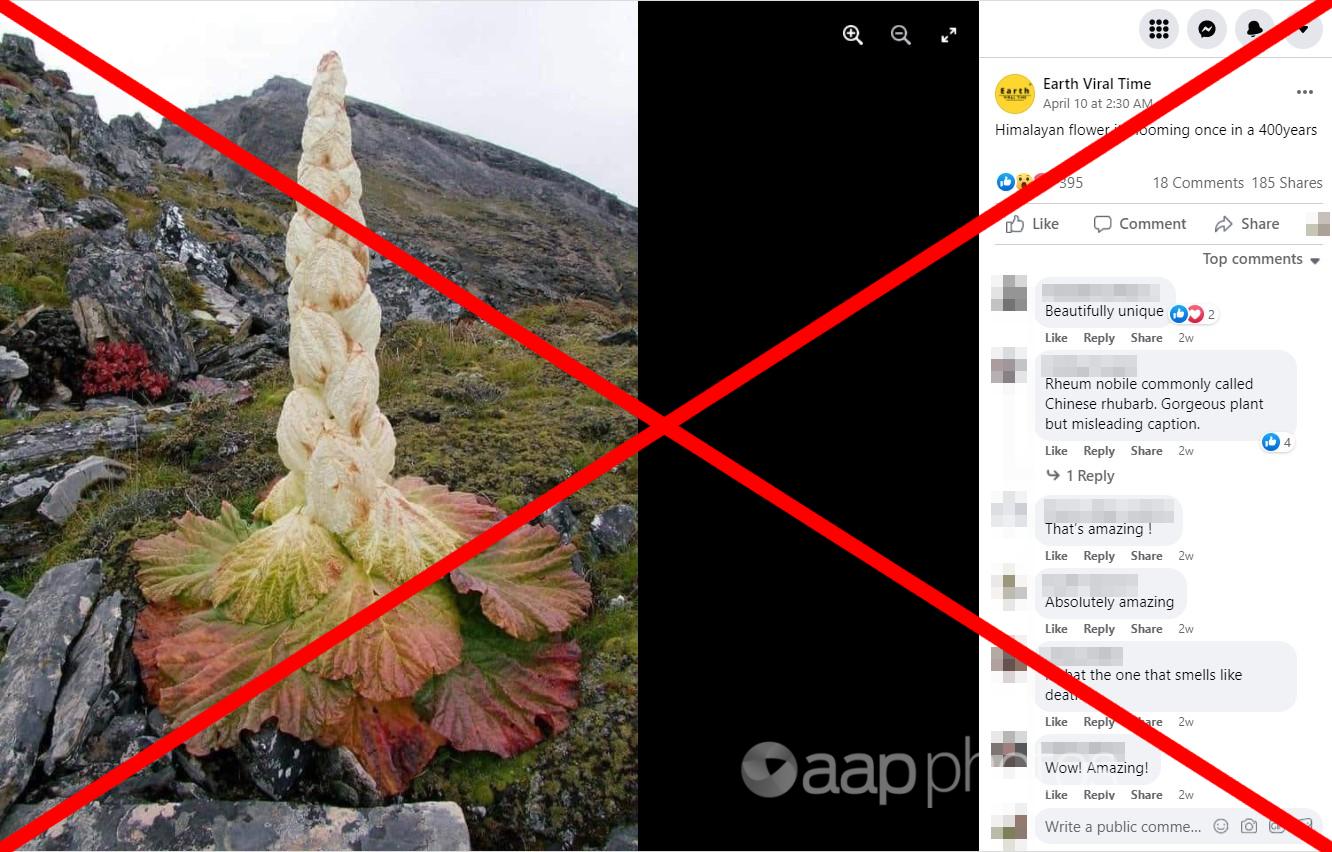While some plants have been known to live for as long as a century before blooming, a social media post claims one spectacular Himalayan flower takes rarity to a new extreme – blossoming only once in 400 years.
But the claim drastically exaggerates the plant’s lifespan. The April 10 Facebook post shows an image of the Rheum nobile, which researchers say flowers once after an average of around 33 years before dying off.
It is not the first time a photo of the same plant has been circulated on social media accompanied by the 400-year claim. In November, 2019, an Instagram user claimed an image of Rheum nobile was a “Mahameru flower that blooms once every 400 years in the Himalayas”, adding that those fortunate enough to see the plant in bloom would receive a “lifetime of good luck”.
The photo used to illustrate the recent post can be traced as far back as a 2009 image uploaded to Flickr, which shows the Rheum nobile in bloom and correctly identifies it by name.
The plant, also known as Sikkim rhubarb, is a monocarpic perennial native to the Himalayas that grows to more than a metre tall. Monocarpic perennials spend at least a year in a vegetative state before flowering once and dying.
Nevertheless, Rheum nobile does not take 400 years to bloom, according to University of Basel professor Jürg Stöcklin, who has co-authored several papers on the plant.

“Rheum nobile is indeed a very spectacular plant because of its life cycle,” he told AAP FactCheck in an email.
The giant herb, which lives at elevations above 4000m in the Himalayas, first grows slowly as a low rosette. When it does flower, it produces a “huge inflorescence“, which can be seen from kilometres away, Prof Stöcklin said.
This “big bang” reproductive event resulted in thousands of seeds being dispersed, after which the plant died, he added.
“Because of the spectacular plant, such myths are understandable, but wrong,” Prof Stöcklin said of the 400-year claim.
Rather, in a 2019 study published in Annals of Botany, Prof Stöcklin and his co-authors estimated the average length of time it took Rheum nobile to reach flowering size was 33.5 years.
Multiple experts contacted by AAP FactCheck could not name any plants in the Himalayas or elsewhere that lasted for as long as 400 years between flowering.
According to Guinness World Records, the slowest-flowering plant is a rare species of giant bromeliad, Puya raimondii, native to mountains in Bolivia. Its flowers appear after between 80-150 years of the plant’s life, the website says.
Paul Licht, emeritus professor at University of California, Berkeley and former director of the university’s botanical garden, which is home to one of the bromeliads, told AAP FactCheck the 80-year estimate came from observations of the so-called ‘Queen of the Andes’ in its natural habitat. However, in the garden it had been observed to flower after only 28 years.
Shashi Babbar, a botany professor from the University of Delhi, said that he did not know of any plant that took a century or more to flower.
“Yes, many plants have long juvenile periods. However, these last for a decade or so. Monocarpic plants like bamboos take 40 years or so to flower and then die off,” Prof Babbar said in an email.
Laurence Dorr, a research botanist at the Smithsonian Museum of Natural History, told AAP FactCheck he could not imagine a plant that blooms every 400 years, adding that few species even lived for that long.
He also noted bamboos included species that only flowered after long periods of time, pointing to a recent review which indicated some varieties could remain in their vegetative phases for as long as 100 years.
Similarly, the talipot palm can live up to 80 years before it flowers, while other species, such as the neelakurinji and titan arum, can grow for a decade or more between flowering.
The Verdict
A viral photo shared on social media does not show a Himalayan plant that blooms every 400 years, as claimed. Rather, it shows a plant, Rheum nobile, that flowers once in its lifetime before dying. Researchers say this occurs after around 33 years, on average.
False – The claim is inaccurate.
* AAP FactCheck is an accredited member of the International Fact-Checking Network. To keep up with our latest fact checks, follow us on Facebook, Twitter and Instagram.
All information, text and images included on the AAP Websites is for personal use only and may not be re-written, copied, re-sold or re-distributed, framed, linked, shared onto social media or otherwise used whether for compensation of any kind or not, unless you have the prior written permission of AAP. For more information, please refer to our standard terms and conditions.


















